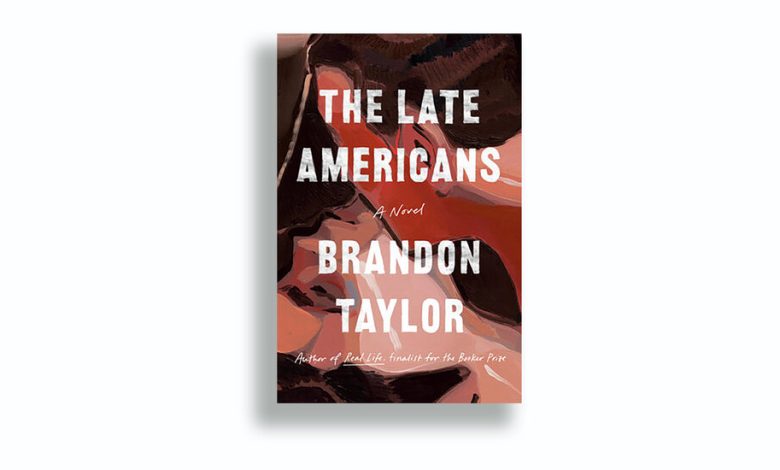For ‘The Late Americans,’ Grad School Life Equals Envy, Sex and Ennui

THE LATE AMERICANS, by Brandon Taylor
Reading Brandon Taylor’s new novel, “The Late Americans,” I thought more than once of the Bad Sex in Fiction Award that the English magazine Literary Review gave to decades of authors, many esteemed, before showing mercy in pandemic-chilled 2020. Not because the sex in Taylor’s novel is described badly, but because — described well! — so much of it is bad.
“Like yelling at the top of your lungs into a vast open field,” thinks one character who’s sleeping with his closeted, trucker-cap-wearing and sometimes violent landlord, Bert, in exchange for an occasional rent discount.
Another, a ballet dancer turned finance student whose live-in pianist boyfriend is cheating on him with a married man, records himself masturbating for an OnlyFans-type site. “There was no pleasure in it,” he thinks. “There was nothing in it at all, except the satisfaction afterward of having moved.” (It probably doesn’t enhance the eroticism that some of the proceeds will go to his parents.)
Sex between two male friends, on a “soiled and sullen mattress,” ends in angry words and a broken bisque bowl.
Erections fail, or fail to manifest entirely. S.T.I. status isn’t communicated in a timely manner. And in a brilliantly sardonic opening scene set at something strongly resembling the Iowa Writers’ Workshop — the elite program from which Taylor got his M.F.A.— poetry scholars argue over the comparison of drying menstrual blood on a comforter, post-intercourse, to a stain on the Gorgon Medusa’s robes after her decapitation.
The women in the class find the metaphor deeply powerful. A male student, Seamus, thinks it — and the general atmosphere of pretension and victimhood in the seminar — so ridiculous he vows to write a retaliatory poem called “Gorgon’s Head.” Forget feelings; this is literature. A higher calling.
Also set in and around the groves of academe, Taylor’s first novel, “Real Life” (2020), was shortlisted for the Booker Prize, but the collection of linked short stories that followed, “Filthy Animals” (2021), was arguably stronger. Debuting with the novel, he told MJ Franklin of The New York Times, was “so that people will let me write short stories in peace.” And you can feel this favored form under the novel-skin of “The Late Americans,” like kittens kicking around in a catsuit.
The pick of the litter is probably the problematic Seamus, who despairs at how terms like “witness and legacy of violence and valid” transform class into “a tribunal for war crimes.” (And what about “problematic,” which makes math of art?) Maker of the bisque and breaker of the bowl, he works in a hospice kitchen to help pay for his education, and has his own unpleasant sexual encounter with Bert, whose father is dying there. But just when the reader’s gotten invested in Seamus, he disappears for over 60 pages.
Taking up the narrative baton are the finance and piano students, Ivan and Goran, and two other dancers, Daw and Noah. Also Fyodor, employed at a meatpacking plant and probably ill-fatedly dating a vegetarian and logician, Timo, who is opposed to the slaughter of animals but supports the death penalty for mass shooters. Painters and others flit into the mix.
A flow chart would be handy to keep track of all the overlapping relationships, career changes and ethnicities here; some gown, some town, some teetering in between. Yet the arbitrariness of opportunity and vocation — who gets to make art? who has to dig ditches? — is clear and pointed. Fyodor brings a sculptor’s sensibility to cuts of beef; Ivan goes from broke to a boundless future in New York in the bright flicker of an email.
Female characters are fewer and more peripheral, though two arrive with force: Fatima, yet another dancer, who chafes at her barista side job and suffers an unwanted pregnancy; and Bea, one of Noah’s neighbors, who was abused by her father, a sturgeon farmer who would “pinch her breasts quite hard and make a sound like a goose.”
She teaches swimming to poor children and, in her spare time, carves fingers out of fiberboard. Older than the various students, she seems to be visiting from another book. (Her encounter with a bloody fingerprint in a playground gave me the same kind of shiver I got from Truman Capote’s classic short story “Miriam.”)
As the title suggests, “The Late Americans” is suffused with nihilism: a sense of a society nearing its end. The hospice patients are obsessed with the extinction of tortoises and other species. The ash trees of Iowa City, planted to replace elms felled by Dutch elm disease, are now succumbing in turn. The young adults struggle in a gig economy, weighed down by student loans or the guilt of trust funds, fantasizing about law school. To Goran, money falls “like dust or snow, floating down in great tufts from his parents and grandparents.” To Fatima, it’s “like an animal, changeful and anxious, ready to flee or bite.”
Along with “the scraggly vapor of marijuana,” the financial crisis of 2008 continues to hang like a toxic doom cloud over these aspirants. “The whole world was just a series of nested shell games involving dwindling sums of money,” Timo thinks, “everyone a little worse off than the person next to them, until you got to the very bottom, where some people had nothing at all.”
Taylor has written a bleak book with flashes of beauty, circling a hothouse of young people on the brink of transplantation into the harsh outside world. His ear for dialogue is exquisitely sensitive. Even if he calls it a novel, I hope he’s working on a play.
THE LATE AMERICANS | By Brandon Taylor | 320 pp. | Riverhead Books | $28
